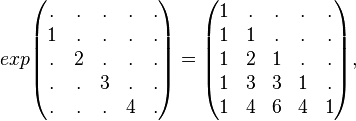注意: 我的班主任给了我这个问题作为作业......我没有被要求这样做,但请告诉我如何用递归来做
可以使用帕斯卡三角形计算二项式系数:
1 n = 0
1 1
1 2 1
1 3 3 1
1 4 6 4 1 n = 4
三角形的每个新级别的两端都有 1;内部数字是它们上面的两个数字的总和。
任务:编写一个包含递归函数的程序,以使用帕斯卡三角技术生成幂 n 的二项式系数列表。例如,
输入 =2输出 = 1 2 1
输入 =4输出 =1 4 6 4 1
到目前为止完成了这个,但告诉我如何用递归来做到这一点......
#include<stdio.h>
int main()
{
int length,i,j,k;
//Accepting length from user
printf("Enter the length of pascal's triangle : ");
scanf("%d",&length);
//Printing the pascal's triangle
for(i=1;i<=length;i++)
{
for(j=1;j<=length-i;j++)
printf(" ");
for(k=1;k<i;k++)
printf("%d",k);
for(k=i;k>=1;k--)
printf("%d",k);
printf("\n");
}
return 0;
}

